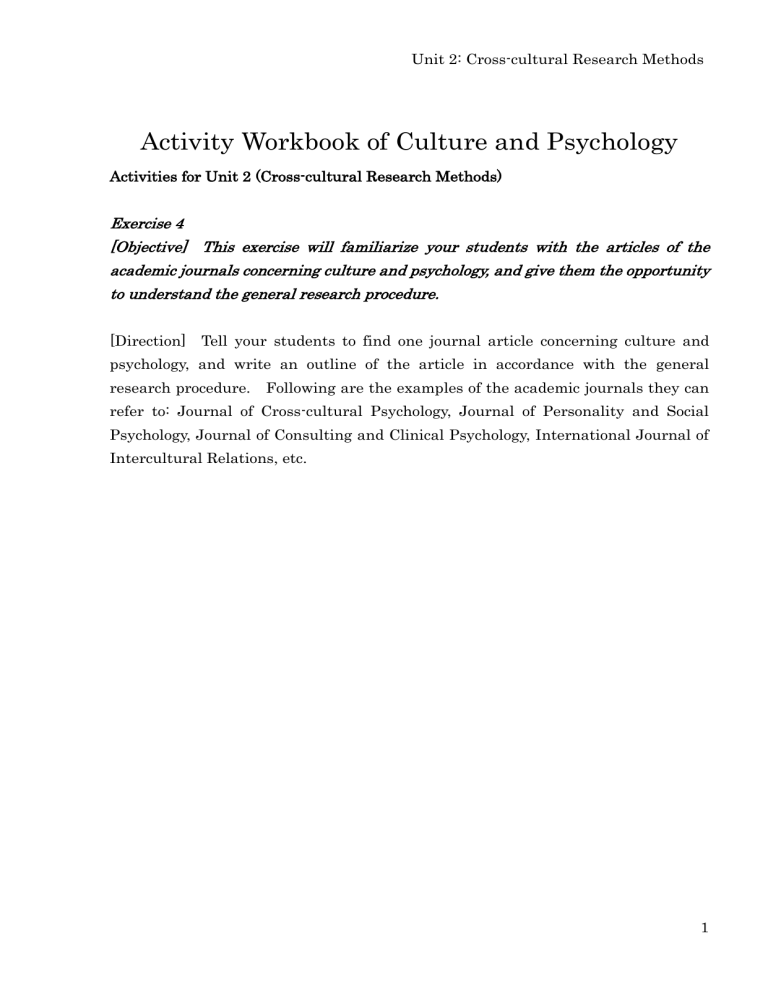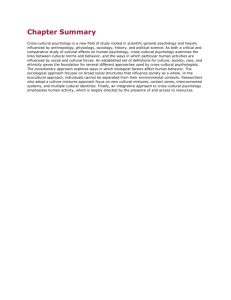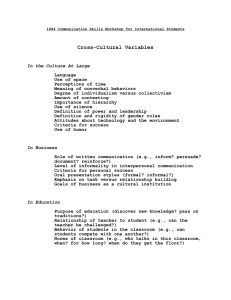
Unit 2: Cross-cultural Research Methods Activity Workbook of Culture and Psychology Activities for Unit 2 (Cross-cultural Research Methods) Exercise 4 [Objective] This exercise will familiarize your students with the articles of the academic journals concerning culture and psychology, and give them the opportunity to understand the general research procedure. [Direction] Tell your students to find one journal article concerning culture and psychology, and write an outline of the article in accordance with the general research procedure. Following are the examples of the academic journals they can refer to: Journal of Cross-cultural Psychology, Journal of Personality and Social Psychology, Journal of Consulting and Clinical Psychology, International Journal of Intercultural Relations, etc. 1 Unit 2: Cross-cultural Research Methods EXERCISE 4 Familiarizing Research Article of Cross-cultural Psychology Student Number: Name: Date: [Direction] Find one journal article concerning culture and psychology and write an outline of the article in accordance with the following research procedure. Select an article from the following academic journals: Journal of Cross-cultural Psychology, Journal of Personality and Social Psychology, Journal of Consulting and Clinical Psychology, International Journal of Intercultural Relations. 1. Title of the Journal (including year of publication of the article): 2. Title and Author(s) of the Article: 3. Topic of the Study: 4. Theories Associated with the Present Study: 5. Hypotheses or Research Questions: 6. Sample of the Study and Selection Procedure: 7. Method Used in the Present Study: 8. Procedure of the Present Study (e.g. How the questionnaire was distributed, how interview was conducted, how experiment was conducted, etc.): 9. Method of Data Analysis: 10. Summary of the Results: 2 Unit 2: Cross-cultural Research Methods 11. Limitation of the Research 12. Description of Future Research 3 Unit 2: Cross-cultural Research Methods Exercise 5 [Objective] This exercise will give your students the opportunity to review the important issues pertinent to conducting cross-cultural research and become familiarized with the general research procedure. [Direction] Tell your students to find one journal article concerning culture and psychology, and evaluate it based on the criteria shown in the sheet called, “Evaluating Cross-cultural Research”. 4 Unit 2: Cross-cultural Research Methods EXERCISE 5 Evaluating Cross-cultural Research Student Number: Name: Date: [Direction] Select one article from the academic journal, such as Journal of Cross-cultural Psychology, Journal of Personality and Social Psychology, Journal of Consulting and Clinical Psychology, International Journal of Intercultural Relations. Then, evaluate the article based on the criteria described below by putting ✓ in each parenthesis. If some aspects of the procedure in the article were not done properly, how would you modify them? Write your alternative solutions. First, describe the reference of the article, such as title of the academic journal, title of the article, author(s)’ name(s) and year of publication: Author(s): Title: Journal: Publication Information: Theory and Hypotheses 1. ( ) Does the theory “make sense” for all the cultures being tested in the study? *If not, describe your solution: 2. ( ) Are the hypotheses meaningfully equivalent for all participants? *If not, describe your solution: Methods 3. ( ) Is the design appropriate for the question being addressed? *If not, describe your solution: 5 Unit 2: Cross-cultural Research Methods 4. ( ) Are the subjects adequate representatives of their culture? *If not, describe your solution: 5. ( ) Is culture operationalized according to socio-psychological constructs? *If not, how is it operationalized ? 6. ( ) Are the subjects equivalent for comparison purposes – no other characteristics or demographic confounds? *If not, describe your solution: 7. ( ) Are the concepts being measured equivalent in all cultures in the study? *If not, describe your solution: 8. ( ) Do the scales, subscales, and items being used have the same reliability and validity characteristics in all cultures in the study? *If not, describe your solution: 9. ( ) Are the scales/constructs contextualized meaningfully for all subjects? *If not, describe your solution: 10. ( ) Do subjects come to the laboratory or complete testing procedures with equivalent expectations? *If not, describe your solution: 11. ( ) Is procedural equivalence established across nuisance parameters of the study? *If not, describe your solution: 12. ( ) Did the researchers establish linguistic equivalence in their methods and research protocols by using back-translation procedures? *If not, describe your solution: 6 Unit 2: Cross-cultural Research Methods Data and Analyses 13. ( ) Do subjects provide data on a level of measurement that is meaningful to them while at the same time equivalent across cultures? *If not, describe your solution: 14. ( ) Are there cultural response sets operating in the data set? *If so, describe your solution: 15. ( ) Do the researchers take adequate steps to check for cultural response sets, and control them if necessary? *If not, describe your solution: 16. ( ) If cultural differences are found, do the researchers provide an index of the size of those differences (effect size statistics)? *If not, describe your solution: Interpretations and Conclusions 17. ( ) Are the interpretations of the findings bound by the cultural filters and biases of the researcher, or of the theories? *If so, describe your solution: 18. ( ) Do the researchers make value judgments based on the findings? *If so, describe your solution: 19. ( ) Are the interpretations sufficiently tempered by awareness of the unconscious cultural processes that may have affected the research or theory? *If not, describe your solution: 20. ( ) Do the researchers make unwarranted cause-effect interpretations of the relationship between culture and their target variables? *If so, describe your solution: 7 Unit 2: Cross-cultural Research Methods 21. ( ) Are the interpretations of cultural mediators justified in relation to how culture was operationalized in the study? *If not, describe your solution: 22. ( ) Are there sufficient methodological concerns to preclude any meaningful conclusions based on the data presented? *If not, describe your solution: Other Questions about the Study Q1. How do the findings contribute to our knowledge with regard to cultural influences on the target variables of interest? Q2. How would changes in any aspect of the methodology affect the outcomes of the study (for example, cultural or demographic backgrounds of the participants, or methods of measuring key variables)? Q3. Can the findings be used by some to foster stereotypes of members of the cultures represented in the study? Q4. Can the findings be used by some to foster prejudice or discrimination against members of the cultures represented in the study? 8 Unit 2: Cross-cultural Research Methods Exercise 6 [Objective] This exercise will give your students the opportunity to familiarize the technique of back translation. 9 Unit 2: Cross-cultural Research Methods EXERCISE 6 Practicing Back Translation Student Number: Name: Date: [Direction] (1) Find a scale that is used to measure some psychological phenomenon. After you have found a scale, choose ten items randomly from that scale. (2) Find two bilingual persons who can understand two of the same languages (e.g., English and Chinese). (3) Give one bilingual person a list of ten items you selected, and ask that person to translate them into a target language (e.g. Chinese). (4) Then, give another bilingual person a translated version of the items (e.g., Chinese) and ask that person to translate them into the original language (e.g., English). (5) Compare the original items and back-translated items. Then, ask your two bilingual assistants about the kind of problems they faced in the process of their task. 1. Describe the author, reference and title of the scale. 2. Describe the target language of translation. 3. List ten items of the original scale you selected. (1) (2) (3) (4) (5) (6) (7) (8) 10 Unit 2: Cross-cultural Research Methods (9) (10) 4. List ten items which were translated into the target language. (1) (2) (3) (4) (5) (6) (7) (8) (9) 5. List ten items which were back-translated into the original language. (1) (2) (3) (4) (5) (6) (7) (8) (9) Question 1: Through the discussion with your assistants, what kind of problems did you identify in connection with back-translation? ・ ・ ・ ・ Question 2: How do you think you are going to solve those problems in your actual study? 11

